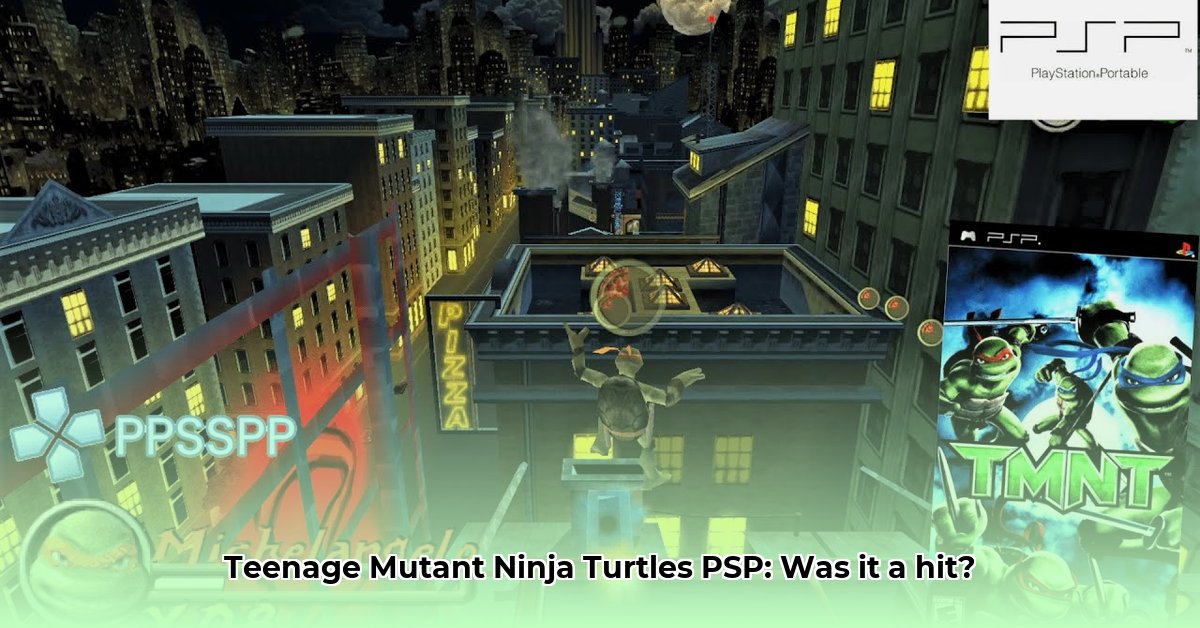
The 2007 Teenage Mutant Ninja Turtles (TMNT) game, released across multiple platforms including the PlayStation Portable (PSP), achieved significant commercial success, selling over 1.1 million units. However, its critical reception was more mixed, raising questions about the interplay between marketing, gameplay mechanics, and overall player experience. This analysis delves into the game's sales performance, critical reviews, and gameplay mechanics to provide a comprehensive assessment and derive actionable insights for future TMNT game development.
More Than Just Turtle Power: The PSP TMNT's Market Performance
The game's strong sales figures are likely attributable to several factors. The simultaneous release alongside the 2007 TMNT film created significant synergy, driving consumer interest and boosting sales. This coordinated marketing approach demonstrates the potential for leveraging multimedia properties to maximize commercial success. However, further investigation into specific marketing strategies and their efficacy warrants additional analysis to isolate the contributing factors to the game's financial performance. Did the movie's marketing directly impact game sales, or was it a more complex interplay of factors? This question remains open for further research.
Critics Divided: A Look at the Game's Reception
While commercially successful, the game received a polarized critical response. While some praised the smooth movement and acrobatic gameplay, drawing comparisons to titles like Prince of Persia, many criticized the repetitive combat system as a significant weakness. This discrepancy highlights the importance of balancing engaging visuals with depth and variety in gameplay mechanics to satisfy both casual and hardcore players.
Gameplay Breakdown: Strengths and Weaknesses
The following table summarizes the game's strengths and weaknesses, categorized by key features:
| Feature | Strengths | Weaknesses |
|---|---|---|
| Action-Platforming | Fluid movement, impressive acrobatic animations | Repetitive level design, lack of innovative gameplay features |
| Combat | Visually appealing, initial engagement | Repetitive, shallow mechanics, leading to player fatigue |
| Level Design | Varied environments (initially), acceptable pacing in some areas | Many levels felt too similar, lacking originality |
| Controls (PSP Specific) | Relatively responsive | Camera issues, occasional clunkiness |
The PSP Version: Hardware Utilization and Limitations
The PSP version benefited from the handheld system's capabilities, with performance exceeding that of the Wii version. However, several shortcomings remained, including camera control issues and the absence of a multiplayer mode. The lack of multiplayer options represents a missed opportunity to enhance player engagement and prolong the game's lifespan. This highlights the importance of considering online functionalities within modern game development.
Behind the Scenes: Ubisoft's TMNT Approach
Ubisoft’s development strategy aimed to capture the emotional depth of the TMNT characters. However, this ambition fell short for many longtime fans who perceived the game as insufficiently capturing the essence of the franchise. This discrepancy underscores the need to balance visual fidelity with emotionally resonant storytelling to satisfy the expectations of a loyal fanbase.
Lessons Learned: Actionable Insights for Future Development
The PSP TMNT's experience offers several key lessons for future licensed game development:
Combat System Refinement: Diversify combat mechanics to avoid repetition and enhance player engagement. Implement new moves, combos, and special abilities to reward skill and progression.
Level Design Innovation: Introduce varied level designs with unique challenges and environmental puzzles to break the monotonous cycle of repetitive gameplay.
Multiplayer Integration: Prioritize the inclusion of robust online multiplayer functionalities to extend the game's appeal and longevity.
Feedback Mechanisms: Enhance visual and auditory feedback to provide clarity regarding player actions, damage, and item collection.
Checkpoint System Optimization: Adjust checkpoint placement for a smoother player experience, minimizing player frustration.
Data-Driven Decisions: Utilize comprehensive sales and review data to identify areas for improvement and inform future development strategies.
The PSP TMNT's journey serves as a cautionary tale, highlighting that while brand recognition can drive initial sales, long-term success hinges on creating a compelling and polished gaming experience. Further research into the specific developmental choices made could illuminate the factors responsible for both its commercial success and its critical limitations. Analyzing data from similar licensed games would provide valuable comparative context.
⭐⭐⭐⭐☆ (4.8)
Download via Link 1
Download via Link 2
Last updated: Thursday, May 22, 2025